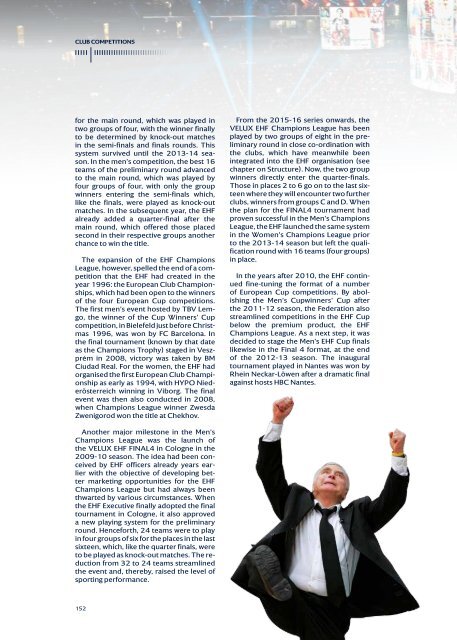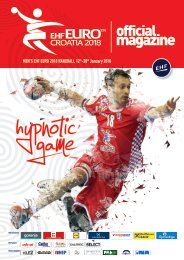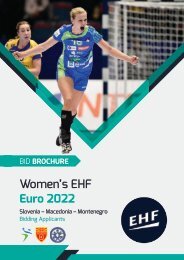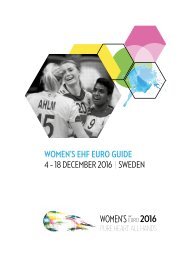ehf_25yers_book_webversion
Create successful ePaper yourself
Turn your PDF publications into a flip-book with our unique Google optimized e-Paper software.
CLUB COMPETITIONS<br />
for the main round, which was played in<br />
two groups of four, with the winner finally<br />
to be determined by knock-out matches<br />
in the semi-finals and finals rounds. This<br />
system survived until the 2013-14 season.<br />
In the men’s competition, the best 16<br />
teams of the preliminary round advanced<br />
to the main round, which was played by<br />
four groups of four, with only the group<br />
winners entering the semi-finals which,<br />
like the finals, were played as knock-out<br />
matches. In the subsequent year, the EHF<br />
already added a quarter-final after the<br />
main round, which offered those placed<br />
second in their respective groups another<br />
chance to win the title.<br />
The expansion of the EHF Champions<br />
League, however, spelled the end of a competition<br />
that the EHF had created in the<br />
year 1996: the European Club Championships,<br />
which had been open to the winners<br />
of the four European Cup competitions.<br />
The first men’s event hosted by TBV Lemgo,<br />
the winner of the Cup Winners’ Cup<br />
competition, in Bielefeld just before Christmas<br />
1996, was won by FC Barcelona. In<br />
the final tournament (known by that date<br />
as the Champions Trophy) staged in Veszprém<br />
in 2008, victory was taken by BM<br />
Ciudad Real. For the women, the EHF had<br />
organised the first European Club Championship<br />
as early as 1994, with HYPO Niederösterreich<br />
winning in Viborg. The final<br />
event was then also conducted in 2008,<br />
when Champions League winner Zwesda<br />
Zwenigorod won the title at Chekhov.<br />
From the 2015-16 series onwards, the<br />
VELUX EHF Champions League has been<br />
played by two groups of eight in the preliminary<br />
round in close co-ordination with<br />
the clubs, which have meanwhile been<br />
integrated into the EHF organisation (see<br />
chapter on Structure). Now, the two group<br />
winners directly enter the quarter-finals.<br />
Those in places 2 to 6 go on to the last sixteen<br />
where they will encounter two further<br />
clubs, winners from groups C and D. When<br />
the plan for the FINAL4 tournament had<br />
proven successful in the Men’s Champions<br />
League, the EHF launched the same system<br />
in the Women’s Champions League prior<br />
to the 2013-14 season but left the qualification<br />
round with 16 teams (four groups)<br />
in place.<br />
In the years after 2010, the EHF continued<br />
fine-tuning the format of a number<br />
of European Cup competitions. By abolishing<br />
the Men’s Cupwinners’ Cup after<br />
the 2011-12 season, the Federation also<br />
streamlined competitions in the EHF Cup<br />
below the premium product, the EHF<br />
Champions League. As a next step, it was<br />
decided to stage the Men’s EHF Cup finals<br />
likewise in the Final 4 format, at the end<br />
of the 2012-13 season. The inaugural<br />
tournament played in Nantes was won by<br />
Rhein Neckar-Löwen after a dramatic final<br />
against hosts HBC Nantes.<br />
Another major milestone in the Men’s<br />
Champions League was the launch of<br />
the VELUX EHF FINAL4 in Cologne in the<br />
2009-10 season. The idea had been conceived<br />
by EHF officers already years earlier<br />
with the objective of developing better<br />
marketing opportunities for the EHF<br />
Champions League but had always been<br />
thwarted by various circumstances. When<br />
the EHF Executive finally adopted the final<br />
tournament in Cologne, it also approved<br />
a new playing system for the preliminary<br />
round. Henceforth, 24 teams were to play<br />
in four groups of six for the places in the last<br />
sixteen, which, like the quarter finals, were<br />
to be played as knock-out matches. The reduction<br />
from 32 to 24 teams streamlined<br />
the event and, thereby, raised the level of<br />
sporting performance.<br />
152














